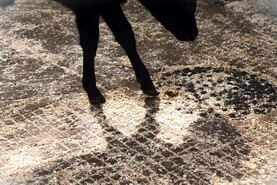More beef bulls and semen used in the dairy herd will help underpin our processing capacity at a critical time. Furthermore, they are more likely to finish at a weight spec of between 280kg and 380kg. Eating quality shouldn’t be an issue either, if they are handled correctly.
It makes sense to dairy farmers to use more beef genetics in their herd. AHDB recently published figures that show a beef-cross calf is worth over £180 more than a dairy bull from the same cow, which is equivalent to 2.28p/litre.
Nevertheless, sucklers are the bedrock of our Scotch brand and the public perception of our systems needs to be maintained. Our premium is the envy of Europe and we need to be mindful of anything that might threaten our elite position.
To keep Scotch beef at the top of the EU price grid, we need to ensure that cows are kept across all of Scotland, the Highlands and the lowlands. They cannot become a small niche sector.
Many suckler farmers may feel threatened by dairy calves coming from businesses whose lifeline is a cheque from a milk processor, while the abattoir cheque isn’t as critical.
But there is a limit to the amount of beef coming from the dairy herd. As the December survey highlights, we only have 175,000 dairy cows, compared to 415,000 beef cows over two years old with offspring.
So it is unlikely that beef from the dairy herd will dominate the Scottish kill any time soon. The focus needs to be on building the beef sector, starting with confidence to invest in cattle.
For suckler farmers looking at the price of straw this winter, the viability of slats looks like an increasingly better option. It might take a few years for straw prices to come down again, so the high initial cost of a new court seems more acceptable. But sadly, with so much up in the air – such as Brexit farm support and trade – you’d be forgiven for not writing a cheque for over £150,000 for a new slatted byre.
Anyone who has met Jim Mclaren will know he is whirlwind of energy and has a real “can do” attitude.
He has fought hard for Scotland’s beef, lamb and pork industries, driving the industry on with relentless positivity.
The more farmers from outside Scotland I meet, the more I understand how strong a reputation we have for our produce.
The hunt will now turn to the next chair of QMS.
Past incumbents have often come from previous NFU Scotland presidents.
However, we could see promotion from within the QMS board: someone from a meat processor or a well-respected farmer.
A table of farmers needed
It is perhaps unfair to criticise the SRUC & Teagasc academic and policymaker conference for a lack of farmers.
But I do feel these events would benefit from a table of farmers to help raise a practical voice, get buy-in from the wider industry and also disseminate messages back to farms in an authentic manner.
Too often we complain that farmers are not taking up best practice and lack focus on efficiency. However, if we had a more open policy towards having experts at farmer meetings and farmers at expert meetings, it would go a long way to improving communication.






 This is a subscriber-only article
This is a subscriber-only article









SHARING OPTIONS: